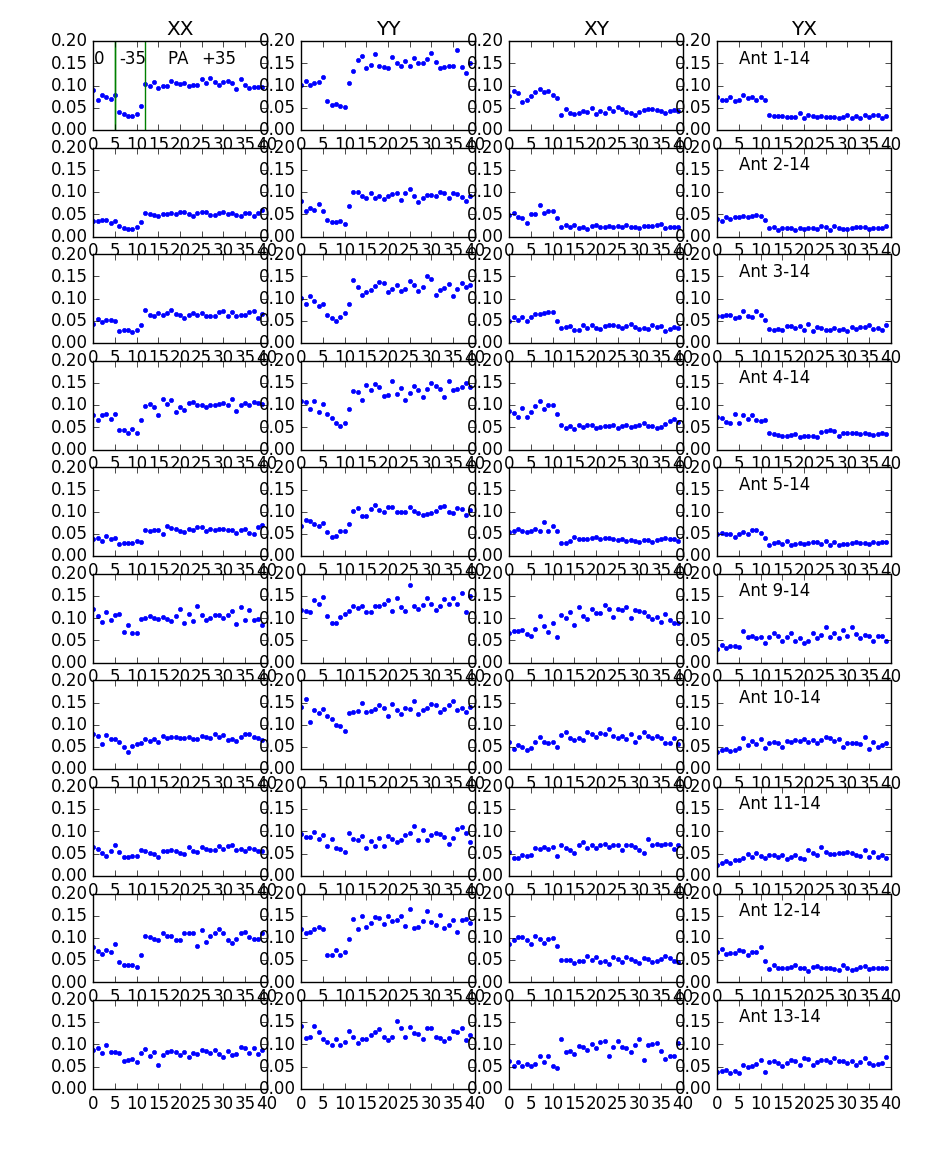2016 November: Difference between revisions
(→Nov 13) |
(→Nov 13) |
||
| Line 51: | Line 51: | ||
'''15:48 UT''' Went to PA +15 degrees (a bit ahead of correct -chi, which is +18 at this moment). | '''15:48 UT''' Went to PA +15 degrees (a bit ahead of correct -chi, which is +18 at this moment). | ||
'''16:10 UT''' Went to PA +10 degrees. | |||
'''17:51 UT''' Went to PA -20 degrees. Obviously a lot of rotation between these two... | |||
Revision as of 17:52, 13 November 2016
Nov 04
19:18 UT Reboot ROACHes to clear fault light and test whether large delays are still present. They were power-cycled and reloaded.
19:24 UT Started roachcal.scd to take packet capture data for checking delays. Still bad!
Nov 05
03:41 UT Found a potential problem in DELAYCAL_END.ctl, so took another two sets of roachcal.scd data. Still bad!
04:14 UT Started roachcal.scd for another set of data. After studying schedule.py, another problem was found. DELAYCAL_END command has to have CIEL-2 as second value on the line, otherwise source id is set to None! Yay! It finally worked!
Nov 09
01:08 UT Set up the schedule to do a long run on 3C84 with the low-frequency receiver, using pcal_lo.fsq (all bands 2.5-6 GHz). One major change is that the PA can be set, so I set it for -30. I would predict that the chi-dependence will shift by 30 degrees (the phase jump will occur at a different hour angle), but the non-intersecting axes issue will cause the same symmetric phase rotation (it depends on elevation only).
04:20 UT 3C84 schedule begins.
12:00 UT 3C84 schedule ends.
Nov 10
03:00 UT Note, the above observations showed no coherence, for reasons unknown. The receiver will be checked for pointing and focus using a total power source. I attempted to observe the Moon at the current time, but it happens to be at -6 Declination, so it is in the geosynchronous satellite belt and could not be peaked up in total power. I will observe Cyg A when it rises at ~ 21:20 UT today.
22:00 UT Began some Cyg A drift scans. Original Z offset was 200, and I could not see any increment on Cyg A, but changing to 50 gave a clear response.
22:20 UT Nominal peak of a drift scan (well seen on baseline 11-14) is 22:20 UT, but it actually occurred at 22:19:55 UT, so original RA offset is right: 0.15 degrees. Also did a Dec drift scan that peaks at 22:46:00 UT, which verifies the DEC offset is also right: 1.03 degrees.
22:49 UT Did a focus scan. This is the time when the focus was best, which corresponds to a focus (Z-axis) setting of 30 on the Lo receiver. Higher settings were significantly worse, so that by a Z-axis setting of 200 the amplitude is going to zero. This explains the lack of phase coherence on the 3C84 run of yesterday.
Nov 13
05:42 UT Attempting to see the Moon with 27-m Hi receiver. I could see nothing at nominal position, but then I got a whopping signal at about 2 degrees RA offset. This might reflect a very wrong X axis position.
05:54 UT Moved X axis setting to 500, and I do get a very high increment at nominal pointing. Best LO Receiver settings X-axis 100, Z-axis 30; Best HI Receiver settings X-axis 500 Y-axis 0.
06:25 UT Began 3C84 observations using HI receiver, with starburst_hi.fsq sequence. Given the much higher signal strength on the Moon, the sensitivity should be very good on 3C84.
06:35 UT Decided to switch to pcal.fsq sequence. This should provide better SNR. Yes! The data look very nice, see Fig. 1 at right.
14:25 UT Going to 3C273, for some PA tests. Oops--used the wrong frequency sequence--was pcal_lo.fsq
14:31 UT Now setting to pcal.fsq
14:37 UT Moved PA position to -35 degrees, which is the current parallactic angle (I will test this and +35 to check the sign).
14:42 UT Began move to PA +35 degrees. I should see a dramatic change in XX and YY amplitudes when feeds are parallel.
15:06 UT Went to PA +29 degrees. Looking at the data, it appears that we need to apply -chi to the PA axis to make the feeds parallel.
15:30 UT Went to PA +23 degrees (tracking chi variation). I did some analysis that verifies -chi is the correct term to apply. See Fig. 2.
15:48 UT Went to PA +15 degrees (a bit ahead of correct -chi, which is +18 at this moment).
16:10 UT Went to PA +10 degrees.
17:51 UT Went to PA -20 degrees. Obviously a lot of rotation between these two...

